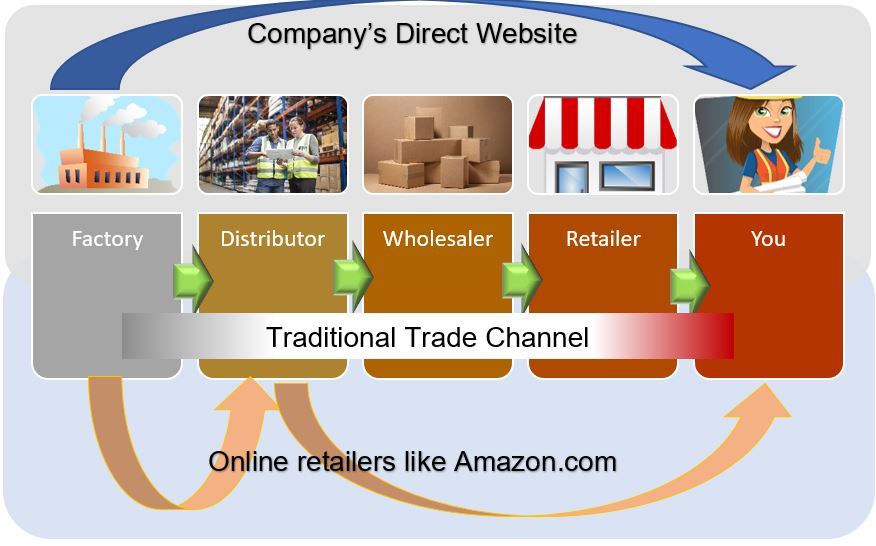Delhi, Sep 16
On a typical day, when we want to buy a phone, we do one of the following:
- Go to a store nearby, select, and buy.
- Go to a website like Amazon.com or any other aggregator website (an aggregator website is a website that collects/aggregates many products and services and presents it at one place) and place our online order.
As you can see in the illustration, in the first case, where the company sells directly to the customer, the company keeps the entire margin, possibly passing on some discount to the customer too. In traditional trade channels, the distributor, wholesaler, and retailer, everyone gets a small profit, and finally the product reaches the consumer. In case of online retailers, they buy the products directly from the company and offer a discount to the end customer. OR, individual distributors who either buy or make things directly sell on Amazon. Amazon keeps a large part of the margin.
Why does the traditional trade channel still work?
As we can clearly see, the product goes through many hands in the traditional trade channel. We can assume that this means that the end product might be the most expensive in this case. Why, then, do companies use traditional trade channels? Why do trade channel partners do this?
Wholesalers and Distributors
- The company does not have to bear the transport costs of sending the product to every part of the country. The wholesalers and distributors do that.
- The company gets its money within a few days or in advance, even if the end customer buys the product 3 or 6 months later. This cost of finance is borne by the trade channel.
- The company does not have to keep its stock safe. It ships the stock out of the factory much faster than if it was selling directly to customers.
- The trade channel is assured of better sales when it deals in recognised brands. The company’s branding and advertising helps them get steady orders.
Retailers
- Retailers provide free advertisement hoardings for the product. Outdoor hoardings are expensive. Can you imagine how much money Samsung, Vivo, Xiaomi, and other manufacturers would have to spend on outdoor hoardings alone if they did not have these sales stores?
- Retailers also provide an important service – customers like to see their product before buying. Especially for high value things. You also might like to see the dress or phone before buying.
- According to a World Bank report released in December 2019, online sales is only 1.6% of India’s total retail sales. This means that if 100 rs are spent by an Indian customer, 98.4 rs are spent in a physical shop. Only 1.6 rs are spent on online platforms like Amazon, Flipkart, and others.
- Retailers prefer to work with established brands for better sales. Even though branded products give much lower margin to the retailer, the retailer thinks that more pieces will sell, so they will make more money.
Some companies try to sell directly to the customer through their own website. Why do this?
- It helps the company get in touch directly with the customer.
- The company makes the highest margin on the product.
The relationship between phone companies like Samsung/Xiaomi and their retailers has been interesting for many months now.
In February 2020, Samsung did a promotion with Amazon Pay. This would have driven sales from retailers to Amazon. The All India Mobile Retailers Association (AIMRA), a body of all the mobile phone retailers in India, decided to boycott the brand for 3 days.
In May 2020, Samsung announced that it has tied up with Facebook to train offline retailers in digital marketing and 800 retailers have been trained in the first phase.
In June 2020, the mobile phone retailers mentioned that both Xiaomi and Samsung are giving more stocks to online retailers and hurting their business. If the best-selling phones are not available in the shop, how will the customer buy? The retailers also said that Samsung is making some phones available at a lower price online in spite of promising that all channels will sell at the same price.
In September 2020, AIMRA has again written to the heads of Samsung India and Xiaomi India. This time, the trade body has mentioned:
- During lockdown, tablet sales soared. But stocks were not provided to Samsung retailers. This meant that other brands sold their tablets and the retail shops lost business. Xiaomi dealers said that they did not get the stock of the best-selling phones.
- The second event is even more interesting. Samsung had distributed gift vouchers worth Rs 10,000 each for prebooking Note20 from retailers. But these vouchers could only be redeemed at Samsung.com. When the customers redeemed their vouchers, they started getting offers of even more discount if they bought from Samsung.com and not the retailer with whom they have placed the original order. This means that the retail shop would lose a confirmed order. Likewise, in the letter to Xiaomi, the retailers mention that customers are being diverted to online sites like Flipkart.com and Mi.com (Xiaomi’s own website).

